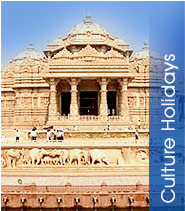Travel Matrix • City Information
City Information
History Of Delhi  "I ASKED MY SOUL WHAT IS DELHI?
SHE REPLIED: THE WORLD IS THE BODY AND
DELHI ITS SOUL."
Abdullah Khan Ghalib
"I ASKED MY SOUL WHAT IS DELHI?
SHE REPLIED: THE WORLD IS THE BODY AND
DELHI ITS SOUL."
Abdullah Khan Ghalib
Delhi, where an empire rose and fell before the dawn of history; where citadels of emperors appeared and disappeared; a city of mysterious eternity whose old ruins proclaim a majestic and imperial past and whose present pulsates vibrantly with the ever flowing life of India. The eternal Yamuna bears witness to the glorious and tumultuous 5,000-year-old history of Delhi. A history, which begins with the creation of Indraprastha by the Pandavas and the transformation of this barren gift of the Kauravas into an idyllic heaven.
In 1950, Delhi was made the capital of Independent India and in 1992 it was declared a state.
Places To Visit
Jama Masjid, Jantar Mantar, Lotus Temple, Old Fort, Qutub Minar, Red Fort, India Gate.
History of Jaipur
Maharaja Jai Singh II, a Kachhwaha Rajput, who ruled from 1699-1744, founded Jaipur, the pink city in 1727. Initially his capital was Amber, which lies at a distance of 11kms from Jaipur. He felt the need of shifting his capital city with the increase in population and growing scarcity of water. Jaipur is the first planned city of India and the King took great interest while designing this city of victory. He consulted several books on architecture and architects before making the lay out of Jaipur.

After several battles with Marathas, Jai Singh was keen on the security aspect of the city. Due to this reason, he focused on his scientific and cultural interests to make a brilliant city. Being, a lover of mathematics and science, Jai Singh sought advice from Vidyadhar Bhattacharya, a Brahmin scholar of Bengal, to aid him design the city architecture. Vidyadhar referred the ancient Indian literature on astronomy, books of Ptolemy and Euclid, and discussed the plan with the King.
With a strategic plan, the construction of the city started in 1727. It took around 4 years to complete the major palaces, roads and square. The city was built following the principles of Shilpa Shastra, the Indian Architecture. The city was divided into nine blocks, out of which two consist the state buildings and palaces, whereas the remaining seven blocks were allotted to the public. In order to ensure the security, huge fortification walls were made along with seven strong gates.
According to that time, architecture of the town was very advanced and certainly the best in Indian subcontinent. In 1853, when Prince of Wales visited Jaipur, the whole city was painted in Pink color to welcome him. Still, the neat and broadly laid-out avenues, painted in pink provide a magical charm to the city. Jaipur is rich in its cultural and architectural beauty, which can be traced in the various historical and aesthetic places that reside in the city. This city of victory really wins the hearts of the people with its splendid charisma.
Places To Visit in Jaipur
Amber Fort, Hawa Mahal, Central Museum, Jaigarh Fort, Jantar Mantar, Nahargarh Fort
City Palace, Kanak Valley, Laxmi Narayan Temple, Rambagh Palace, Sisodia Rani Ka Bagh
History of Ajmer
Raja Ajaipal Chauhan who named it 'Ajaimeru' or 'The Invincible Hill' founded the city of Ajmer in the 7th century. Close by the king built Taragarh, the very first hill fort in India. It remained an important Chauhan stronghold till 1193, when the Afghan Mohammed Ghori defeated the last Hindu ruler, Prithviraj Chauhan. For over three centuries thereafter, Ajmer faced turbulent times changing hands over and over again as one warlord succeeded another. Finally, a part of the great Mughal Empire, Emperor Akbar accorded it the status of a province in 1556, and used it as the headquarters for his campaigns in Rajasthan.
Places to visit
Famous Dargah Sharif, Remarkable Adhai-din-ka-Jhonpara, Taragarh Fort, Nag Pahar(Snake Mountain)
History Of Pushkar
Though it is only 11 km from Ajmer, the little pilgrim town of Pushkar transports you to another world. The road from Ajmer crosses a pass in the Aravalli Hills called Nag Parbat (Snake Mountain), and brings into view the tranquil lake and the peaceful temple town set by its side.
According to legend the holy Pushkar Lake sprang up when a lotus petal fell from the hand of Lord Brahma, the Creator. It has the same sanctity for the Hindus as the Mansarovar Lake in Tibet, and devout Hindus aspire to come here at least once in their lifetime.
Places to visit
Brahma Temple, Rangaji Temple, Savitri Temple, Famous Pushkar Fair












